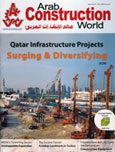
Saving Global Infrastructure with Crystalline Waterproofing
Media » News April 28, 2013
Water is concrete’s worst aggressor and is the cause of nearly all deterioration. Concrete is a naturally porous material where cracks and crevices act as passages for water to enter the concrete matrix, making contact with reinforcing steel and causing corrosion. Corrosion then causes the steel to expand and as a result, the surrounding concrete that encases it bulges and causes structural damage. To safeguard against this type of damage to concrete, waterproofing is necessary. In fact, concrete waterproofing is the real-life solution to failing infrastructure and can extend the service life by decades.
“Crystalline integral waterproofing systems can be effectively used with cast-in-place, shotcrete or pre-cast methods”
There is extensive evidence to show that concrete structures all over the world are deteriorating at a rate that exceeds their service life. The Big 5 reports that a senior research engineer at Saudi Arabia’s King Fahd University of Petroleum and Minerals (KFUPM) said that “concrete deterioration in the Kingdom is causing an estimated annual loss of 2 billion Saudi Riyal.” Several studies indicate that politicians, planners and specifiers on a global level need to be forward thinking and willing to implement long-term strategies which will save millions of dollars in repair costs down the road. This revelation has focused attention on proven permanent concrete waterproofing technology – integral crystalline waterproofing.

Crystalline technology comes in the form of a dry powder that can be added directly to the concrete mix or applied to the existing concrete surface. The crystalline chemicals will facilitate crystal growth, which transforms concrete into a waterproof barrier. Long, narrow crystals grow within the concrete matrix and block the flow of water by filling the natural pores, capillaries and hairline cracks in concrete. These integral waterproofing systems become more effective with time, and will last the lifetime of the structure. The system cannot wear away, puncture, tear or become damaged like traditionally used sheet membranes. Crystalline integral waterproofing systems can be effectively used with cast-in-place, shotcrete or pre-cast methods and are not limited by corners, seams or odd-shaped areas. Because crystalline admixtures are integrated into the concrete mix, required labor and potential for human error is reduced and backfilling can begin as soon as the concrete hardens, saving time on the construction site.
The most recent version of the American Concrete Institute’s ACI 212.3R-10: Report on Chemical Admixtures for Concrete devoted a new chapter (Chapter 15) to Permeability Reducing Admixtures (PRA) which defines new PRAH and PRAN classifications.
PRAN – Permeability Reducing Admixture for Non-Hydrostatic Conditions PRAH – Permeability Reducing Admixture for Hydrostatic Conditions
Kryton International Inc.’s Krystol Internal Membrane or KIM is the only admixture that demonstrates the performance of a hydrophilic crystalline, PRAH. KIM provides the highest level of water resistance, self-sealing and field-proven longevity, which proves its effectiveness as a PRAH. The experts can see that with the selection of the most effective concrete waterproofing system, the service life of infrastructures can be extended for a better financial and environmental outlook. When governmental bodies are building better, with innovative technologies, they have the potential to curb the rising costs of infrastructure maintenance for decades to come.
 Crystalline technology comes in the form of a dry powder that can be added directly to the concrete mix or applied to the existing concrete surface. The crystalline chemicals will facilitate crystal growth, which transforms concrete into a waterproof barrier. Long, narrow crystals grow within the concrete matrix and block the flow of water by filling the natural pores, capillaries and hairline cracks in concrete. These integral waterproofing systems become more effective with time, and will last the lifetime of the structure. The system cannot wear away, puncture, tear or become damaged like traditionally used sheet membranes. Crystalline integral waterproofing systems can be effectively used with cast-in-place, shotcrete or pre-cast methods and are not limited by corners, seams or odd-shaped areas. Because crystalline admixtures are integrated into the concrete mix, required labor and potential for human error is reduced and backfilling can begin as soon as the concrete hardens, saving time on the construction site.
Crystalline technology comes in the form of a dry powder that can be added directly to the concrete mix or applied to the existing concrete surface. The crystalline chemicals will facilitate crystal growth, which transforms concrete into a waterproof barrier. Long, narrow crystals grow within the concrete matrix and block the flow of water by filling the natural pores, capillaries and hairline cracks in concrete. These integral waterproofing systems become more effective with time, and will last the lifetime of the structure. The system cannot wear away, puncture, tear or become damaged like traditionally used sheet membranes. Crystalline integral waterproofing systems can be effectively used with cast-in-place, shotcrete or pre-cast methods and are not limited by corners, seams or odd-shaped areas. Because crystalline admixtures are integrated into the concrete mix, required labor and potential for human error is reduced and backfilling can begin as soon as the concrete hardens, saving time on the construction site.